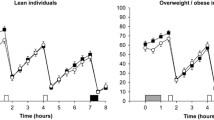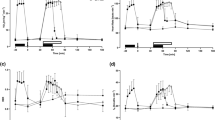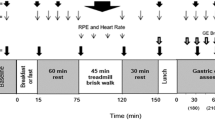Abstract
Postprandial insulin release is lower in healthy aerobically trained (T) compared to untrained (UT) individuals. This may be mediated by a lower release of the two incretin hormones [glucagon like peptide-1 (GLP-1) and glucose-dependent insulinotropic polypeptide (GIP)] in T. The aim of this study was to assess and compare gut hormone response and satiety changes after a liquid meal intake in young, healthy T and UT males. Postprandial gut hormone release and subjective feelings of hunger, satiety, fullness and prospective food consumption were assessed before and frequently for the following 3 h after a 200 ml liquid meal (1,260 kJ and 27, 41 and 32 energy % as protein, carbohydrates and fat, respectively) in ten T and ten UT young, healthy male subjects. The insulin and GIP responses were markedly lower in T than UT and correlated during the first 30 min after the liquid meal. Baseline GLP-1 concentration was higher in T versus UT, but the response in the following 3 h after a liquid meal was similar in T and UT. Satiety measures did not differ between groups throughout the test. It is possible that in aerobically T subjects, a lower GIP release is partly responsible for a lower postprandial incretin stimulated insulin secretion.






Similar content being viewed by others
Abbreviations
- IL-6:
-
Interleukin-6
- PP:
-
Pancreatic polypeptide
- PFC:
-
Prospective food consumption
- T:
-
Aerobically trained
- UT:
-
Untrained
- VO2max:
-
Maximal oxygen uptake
- FFA:
-
Free fatty acids
- DPP-4:
-
Dipeptidyl peptidase-4
- GLP-2:
-
Glucagon-like peptide-2
- AUC:
-
Area under the curve
- BMI:
-
Body mass index
- LBM:
-
Lean body mass
- GIP:
-
Glucose-dependent insulinotropic polypeptide
- GLP-1:
-
Glucagon-like peptide-1
- PYY:
-
Peptide YY
- VIP:
-
Vasoactive intestinal polypeptide
References
Aarnio P, Lauritsen T, Dela F (2001) Insulin secretion and glucose kinetics during exercise with and without pharmacological alpha(1)- and alpha(2)-receptor blockade. Diabetes 50:1834–1843
Brooks GA, Mercier J (1994) Balance of carbohydrate and lipid utilization during exercise: the “crossover” concept. J Appl Physiol 76:2253–2261
Broom DR, Stensel DJ, Bishop NC, Burns SF, Miyashita M (2007) Exercise-induced suppression of acylated ghrelin in humans. J Appl Physiol 102:2165–2171
Broom DR, Batterham RL, King JA, Stensel DJ (2009) Influence of resistance and aerobic exercise on hunger, circulating levels of acylated ghrelin, and peptide YY in healthy males. Am J Physiol Regul Integr Comp Physiol 296:R29–R35
Caudwell P, Finlayson G, Gibbons C, Hopkins M, King N, Naslund E, Blundell JE (2013) Resting metabolic rate is associated with hunger, self-determined meal size, and daily energy intake and may represent a marker for appetite. Am J Clin Nutr 97:7–14
Dela F, Mikines KJ, Von LM, Galbo H (1991) Effect of training on response to a glucose load adjusted for daily carbohydrate intake. Am J Physiol 260:E14–E20
Dela F, Mikines KJ, Von LM, Secher NH, Galbo H (1992) Effect of training on insulin-mediated glucose uptake in human muscle. Am J Physiol 263:E1134–E1143
Dupre J, Ross SA, Watson D, Brown JC (1973) Stimulation of insulin secretion by gastric inhibitory polypeptide in man. J Clin Endocrinol Metab 37:826–828
Essen-Gustavsson B, Henriksson J (1984) Enzyme levels in pools of microdissected human muscle fibres of identified type. Adaptive response to exercise. Acta Physiol Scand 120:505–515
Faerch K, Borch-Johnsen K, Holst JJ, Vaag A (2009) Pathophysiology and aetiology of impaired fasting glycaemia and impaired glucose tolerance: does it matter for prevention and treatment of type 2 diabetes? Diabetologia 52:1714–1723
Galbo H (1983) Hormonal and metabolic adaptation to exercise. Thieme-Stratton Inc, New York
Galbo H, Holst JJ, Christensen NJ (1975) Glucagon and plasma catecholamine responses to graded and prolonged exercise in man. J Appl Physiol 38:70–76
Greenberg GR, Pokol-Daniel S (1994) Neural modulation of glucose-dependent insulinotropic peptide (GIP) and insulin secretion in conscious dogs. Pancreas 9:531–535
Hansen L, Lampert S, Mineo H, Holst JJ (2004) Neural regulation of glucagon-like peptide-1 secretion in pigs. Am J Physiol Endocrinol Metab 287:E939–E947
Hartmann B, Johnsen AH, Orskov C, Adelhorst K, Thim L, Holst JJ (2000) Structure, measurement, and secretion of human glucagon-like peptide-2. Peptides 21:73–80
Hilsted J, Galbo H, Sonne B, Schwartz T, Fahrenkrug J, de Muckadell OB, Lauritsen KB, Tronier B (1980) Gastroenteropancreatic hormonal changes during exercise. Am J Physiol 239:G136–G140
Holloszy JO (2008) Regulation by exercise of skeletal muscle content of mitochondria and GLUT4. J Physiol Pharmacol 59(Suppl 7):5–18
Holloszy JO, Skinner JS, Barry AJ, Cureton TK (1964) Effect of physical conditioning on cardiovascular function. A ballistocardiographic study. Am J Cardiol 14:761–770
Holst JJ (1982) Evidence that enteroglucagon (II) is identical with the C-terminal sequence (residues 33–69) of glicentin. Biochem J 207:381–388
Holst JJ (2007) The physiology of glucagon-like peptide 1. Physiol Rev 87:1409–1439
Holst JJ, Orskov C, Nielsen OV, Schwartz TW (1987) Truncated glucagon-like peptide I, an insulin-releasing hormone from the distal gut. FEBS Lett 211:169–174
Kelly KR, Brooks LM, Solomon TP, Kashyap SR, O’Leary VB, Kirwan JP (2009) The glucose-dependent insulinotropic polypeptide and glucose-stimulated insulin response to exercise training and diet in obesity. Am J Physiol Endocrinol Metab 296:E1269–E1274
King NA, Lluch A, Stubbs RJ, Blundell JE (1997) High dose exercise does not increase hunger or energy intake in free living males. Eur J Clin Nutr 51:478–483
King NA, Hopkins M, Caudwell P, Stubbs RJ, Blundell JE (2008) Individual variability following 12 weeks of supervised exercise: identification and characterization of compensation for exercise-induced weight loss. Int J Obes (Lond) 32:177–184
King JA, Wasse LK, Ewens J, Crystallis K, Emmanuel J, Batterham RL, Stensel DJ (2011) Differential acylated ghrelin, peptide YY3-36, appetite, and food intake responses to equivalent energy deficits created by exercise and food restriction. J Clin Endocrinol Metab 96:1114–1121
Kjaer M, Galbo H (1988) Effect of physical training on the capacity to secrete epinephrine. J Appl Physiol 64:11–16
Legakis IN, Mantzouridis T, Saramantis A, Phenekos C, Tzioras C, Mountokalakis T (2000) Human galanin secretion is increased upon normal exercise test in middle-age individuals. Endocr Res 26:357–364
Leidy HJ, Gardner JK, Frye BR, Snook ML, Schuchert MK, Richard EL, Williams NI (2004) Circulating ghrelin is sensitive to changes in body weight during a diet and exercise program in normal-weight young women. J Clin Endocrinol Metab 89:2659–2664
Manshouri M, Ghanbari-Niaki A, Kraemer RR, Shemshaki A (2008) Time course alterations of plasma obestatin and growth hormone levels in response to short-term anaerobic exercise training in college women. Appl Physiol Nutr Metab 33:1246–1249
Martins C, Truby H, Morgan LM (2007) Short-term appetite control in response to a 6-week exercise programme in sedentary volunteers. Br J Nutr 98:834–842
Martins C, Kulseng B, King NA, Holst JJ, Blundell JE (2010) The effects of exercise-induced weight loss on appetite-related peptides and motivation to eat. J Clin Endocrinol Metab 95:1609–1616
Martins C, Kulseng B, Rehfeld JF, King NA, Blundell JE (2013) Effect of chronic exercise on appetite control in overweight and obese individuals. Med Sci Sports Exerc 45:805–812
Mikines KJ, Sonne B, Tronier B, Galbo H (1989) Effects of training and detraining on dose-response relationship between glucose and insulin secretion. Am J Physiol 256:E588–E596
Nappo F, Esposito K, Cioffi M, Giugliano G, Molinari AM, Paolisso G, Marfella R, Giugliano D (2002) Postprandial endothelial activation in healthy subjects and in type 2 diabetic patients: role of fat and carbohydrate meals. J Am Coll Cardiol 39:1145–1150
O’Connor AM, Johnston CF, Buchanan KD, Boreham C, Trinick TR, Riddoch CJ (1995) Circulating gastrointestinal hormone changes in marathon running. Int J Sports Med 16:283–287
Orskov C, Holst JJ, Knuhtsen S, Baldissera FG, Poulsen SS, Nielsen OV (1986) Glucagon-like peptides GLP-1 and GLP-2, predicted products of the glucagon gene, are secreted separately from pig small intestine but not pancreas. Endocrinology 119:1467–1475
Orskov C, Rabenhoj L, Wettergren A, Kofod H, Holst JJ (1994) Tissue and plasma concentrations of amidated and glycine-extended glucagon-like peptide I in humans. Diabetes 43:535–539
Ravussin E, Lillioja S, Anderson TE, Christin L, Bogardus C (1986) Determinants of 24-hour energy expenditure in man. Methods and results using a respiratory chamber. J Clin Invest 78:1568–1578
Rocca AS, Brubaker PL (1999) Role of the vagus nerve in mediating proximal nutrient-induced glucagon-like peptide-1 secretion. Endocrinology 140:1687–1694
Romon M, Gomila S, Hincker P, Soudan B, Dallongeville J (2006) Influence of weight loss on plasma ghrelin responses to high-fat and high-carbohydrate test meals in obese women. J Clin Endocrinol Metab 91:1034–1041
Scheid JL, de Souza MJ, Leidy HJ, Williams NI (2011) Ghrelin but not peptide YY is related to change in body weight and energy availability. Med Sci Sports Exerc 43:2063–2071
Soffer EE, Merchant RK, Duethman G, Launspach J, Gisolfi C, Adrian TE (1993) Effect of graded exercise on esophageal motility and gastroesophageal reflux in trained athletes. Dig Dis Sci 38:220–224
Tschop M, Weyer C, Tataranni PA, Devanarayan V, Ravussin E, Heiman ML (2001) Circulating ghrelin levels are decreased in human obesity. Diabetes 50:707–709
Vilsboll T, Krarup T, Madsbad S, Holst JJ (2003) Both GLP-1 and GIP are insulinotropic at basal and postprandial glucose levels and contribute nearly equally to the incretin effect of a meal in healthy subjects. Regul Pept 114:115–121
Acknowledgments
We thank the laboratory technician Jeppe Bach for his technical assistance during the study.
Conflict of interest
The authors declare that there is no conflict of interest associated with this manuscript.
Author information
Authors and Affiliations
Corresponding author
Additional information
Communicated by Keith Phillip George.
Rights and permissions
About this article
Cite this article
Lund, M.T., Taudorf, L., Hartmann, B. et al. Meal induced gut hormone secretion is altered in aerobically trained compared to sedentary young healthy males. Eur J Appl Physiol 113, 2737–2747 (2013). https://doi.org/10.1007/s00421-013-2711-y
Received:
Accepted:
Published:
Issue Date:
DOI: https://doi.org/10.1007/s00421-013-2711-y




